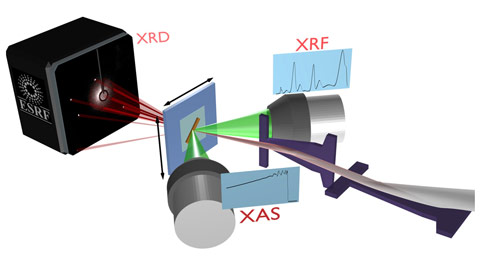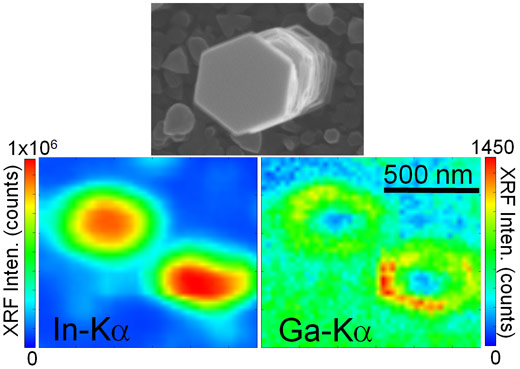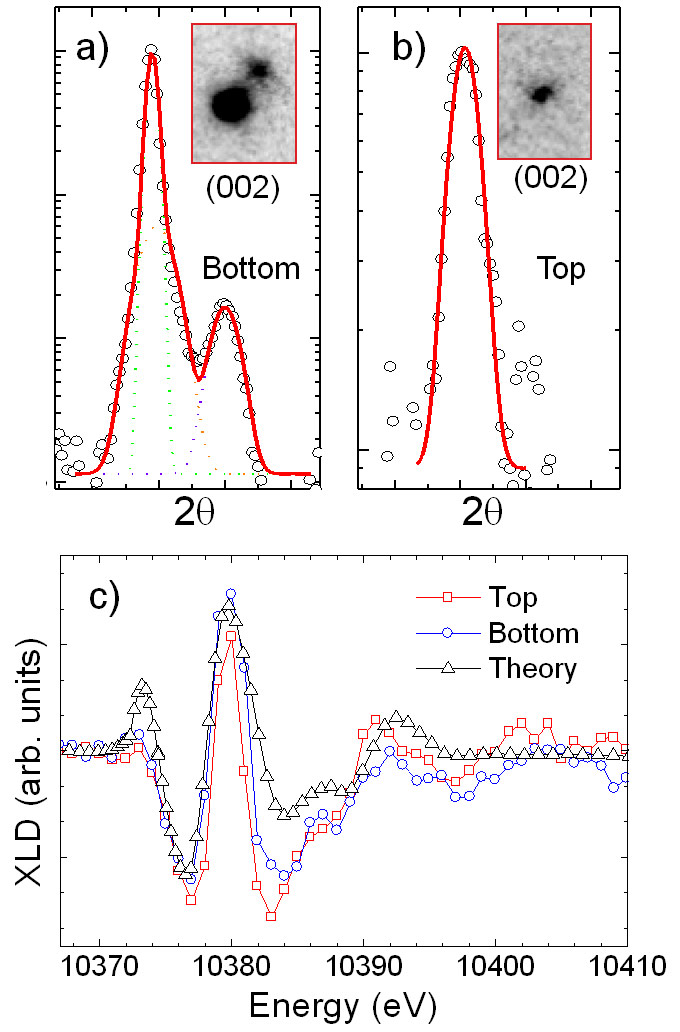- Home
- News
- Spotlight on Science
- Phase separation...
Phase separation in single InGaN nanowires revealed by a hard X-ray synchrotron nanoprobe
25-04-2014
The composition and the short- and long-range structural order of single InxGa1−xN nanowires were investigated using a hard X-ray synchrotron nanoprobe. Various spectroscopic techniques including nano-XRF, polarisation dependent nano-XANES, and nano-XRD were combined to reveal a large phase separation at the bottom, and a single phase at the top of the nanowires. We anticipate that the methodology presented here will contribute to a better understanding of the underlying growth concepts of many nanostructures in materials science.
Unique properties and improved device functionalities can be achieved using materials and heterostructures with nanometric sizes. However, the characterisation of these complex structures requires the combination of several techniques, preferably with a high spatial resolution to avoid the averaging that could hide relevant local properties. In the present work, the hard X-ray nanoprobe ID22NI (now installed at the upgraded beamline ID16B) has been used to study self-assembled InxGa1−xN nanowires. Such nanowires are of great technological interest for the development of high efficiency multijunction solar cells [1], light emitting diodes, and lasers [2].
Figure 1 shows a sketch of the multitechnique setup at the X-ray nanoprobe ID22NI, which incorporates X-ray fluorescence (XRF), X-ray diffraction (XRD) and X-ray absorption spectroscopy (XAS). Combining these techniques allows the simultaneous investigation of the composition and the long- and short-range order of samples with nanometre lateral resolution.
 |
|
Figure 1. Multitechnique setup at the nanoimaging station ID22NI (Replaced by the upgraded beamline ID16B). |
The as-grown and dispersed nanowires were placed onto thin SiN membranes in order to reduce the XRF background and to let the X-ray diffraction signal pass through. The samples were scanned with both pink beams (ΔE/E ~ 10−2, flux of about 5 × 1012 ph/s, 55 × 55 nm2 size) and monochromatic beams (ΔE/E ~ 10−4, flux of about 5 × 1010 ph/s, 105 × 110 nm2 size). The XRF maps of the nanowires (for example, those displayed in Figure 2) show an axial and radial elemental heterogeneity with Ga accumulation in the bottom and in the outer region of the nanowire.
 |
|
Figure 2. SEM image (top), In (left) and Ga (right) Kα XRF maps of representative single dispersed and as-grown nanowires on the Si substrate, taken from the top. |
Nano-XRD and nano-XRF maps were measured simultaneously on single dispersed nanowires, using a 28 keV monochromatic beam. Figure 3 shows the XRD data of the InGaN (002) reflection acquired at the bottom (a) and top (b) of a single nanowire. A closer inspection of the (002) reflection shows at least three Gaussian-shaped contributions at the bottom, and a single Gaussian-like XRD peak at the top. These different contributions to the (002) diffraction are observed even in the original CCD images (shown in the insets of Figures 3a and 3b), they are associated with regions in the nanowires having different composition. Finally, Figure 3c shows the X-ray linear dichroism spectra around the Ga K-edge measured at the top and bottom of a single nanowire, and the calculated spectrum for wurtzite GaN. Both XLD spectra of the nanowire exhibit the strong anisotropy in the X-ray absorption, typical for the wurtzite GaN matrix. This confirms that, despite the compositional modulation, the tetrahedral order around the Ga absorbing atoms remains throughout the length of the nanowires.
Principal publication and authors
J. Segura-Ruiz (a), G. Martinez-Criado (a), C. Denker (b), J. Malindretos (b), and A. Rizzi (b). Phase separation in single InxGa1-xN nanowires revealed through a hard X-ray synchrotron nanoprobe, Nano Letters 14, 1300 (2014).
(a) ESRF
(b) IV. Physikalisches Institut, Georg-August-Universität Göttingen (Germany)
References
[1] B. Tian, X. Zheng, T.J. Kempa, Y. Fang, N. Yu, G. Yu, J. Huang, C.M. Lieber, Nature 449, 885 (2007).
[2] F. Qian, Y. Li, S. Gradecăk, H.-G- Park, Y. Dong, Y. Ding, Z.L. Wang, C.M. Lieber, Nat. Mater. 7, 701 (2008).
Top image: Fluorescence maps indicating indium and gallium distribution within tiny 500 nm-wide nanowires.




